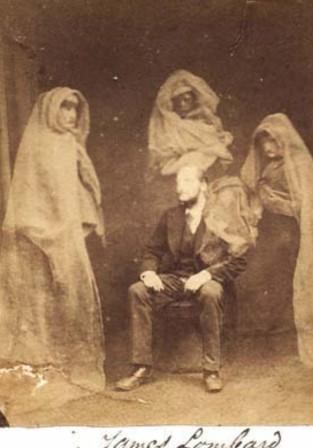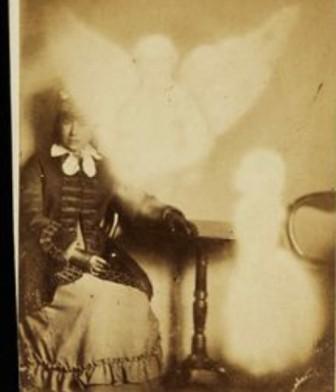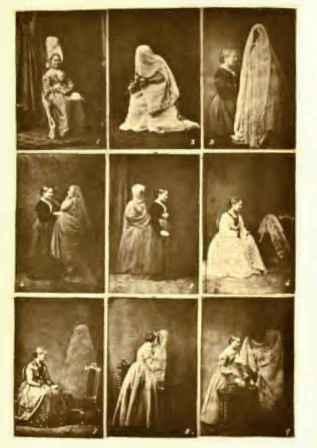IF KNOCK VISION WERE REPORTED IN USA OR UK IT WOULD BE DISMISSED AS SPIRITUALIST TRICKERY
On the night of the 21st of August 1879 the Virgin Mary flanked by St Joseph and a bishop thought to be St John the Evangelist and an altar with a lamb and cross on it allegedly appeared on the gable wall of the Parish Church of Knock for a few hours. Fifteen people witnessed the vision including a child of five (page 60, The Evidence for Visions of the Virgin Mary). Witness statements were published in a highly altered and edited form that differed hugely from the real ones the witnesses made. That witnesses didn't do the slightest thing about the lies speaks strongly against them as honest people.
In a culture rife with saints in white robes and statues depicting them, it is understandable that anything in white robes could be taken for a heavenly visitation.
This image below shows that robed figures were in the fraudster's consciousness back then. Here is an image from the same decade as the Knock "vision". It was a faked photo of the dead that was made in Spiritualist circles.

The first figure is like the Knock lady who appeared in the middle minus a crown. The figure behind the man could pass with high head gear could pass for a bishop and seems to be holding something. John was thought to be holding a book. The crouched figure on the left is bent like Joseph reportedly was at Knock towards Mary.
Here is an image showing an angel and some reported angels at Knock that also was concocted among Spiritualists.

None of those people knew what was supposed to be around them until the photo was ready. Knock wanes in credibility when we have people being involved in visions that could only be developed on camera and believing it all!

Back to Knock. What do we know about what they saw?
The images did not move. But the first witnesses
who said they saw motion could have made a mistake or just seen a slight
repositioning of the vision. None of them say the entities moved as in living
creature.
The image was ghostly and vague.
The colours were wrong - eg Mary has a yellowish face.
There was a place where to place the magic lantern.
There is no evidence that the image was seen in daylight.
Nobody seen the images coming or going.
Nobody was asked if there was anything odd like a prop anywhere.
What we have seen shows it may have been some kind of projector. Magic lanterns were popular at the time.
The magic lantern explanation became a major theory.
Objections to the theory in the past hovered around the
thought that any projection would be too unimpressive. But it could have
been good and even if it were not then Joe Nickell helps us, "The ability to see
pictures in random forms—as in clouds, tea leaves, and inkblots—is known as
pareidolia; the images themselves are called simulacra." It could be that there
was a lantern involved which gave a vague rubbish image and imagination did the
rest. Pareidolia supports the magic lantern theory. For all you know, it
could have been meant to be an appearance of ghosts with a coffin mistaken for
an altar. It could have been a joke that went wrong.
It suited the Archdeacon too well. He needed a wonder to save him from
being attacked by some enemies. And his behaviour on the night of the vision
was odd. For example, he pretended to think the story he heard was untrue though
he had a clear view of the "miracle" from his window. He made too much of alleged cures which shows he was willing to fool
himself to fool others.
The Church cites smart people who said there was no evidence of hoaxing. But
absence of evidence is not evidence of absence. It is typical of the Catholic
Church to use people who have academic prestige but who are not qualified or
experienced to refute people's doubts about the reality of miracles. It is
really a magician who should be deployed. Even scientists can be fooled by good
trickery. Magicians in the 19th century were known to be able to project ghostly
images unto glass sheets. This stage trick fooled the audience into thinking
they were seeing ghosts.
Magic lantern/phantasmagoria facts
Magic lanterns were early projectors.
Loutherbourg in the 1700's was able to make images of Satan and his demons in
Hell for an audience (page 152).
There is an account of the appearance of the Red Woman of Berlin in 1825. Paul
de Philipsthal, Philidor, set up this illusion using a magic lantern. A witness
wrote that "the effect was electrical" and mentioned the hysterical screams of
women in the audience. The males began to panic and made for the door. The light
had to be turned on to pacify the audience. Page 150. This shows how good the
images could be.
In 1832, David Brewster, wrote about the double mirror trick. This trick is
called Dr Pepper's Ghost. Two panes of glass are used to make a spectre made by
a magic lantern hover in mid-air on a stage (page 153).
Magic lanterns originally used candles.
Robertson, born 1863 in Belgium, began to use the Argand Oil Lamp which was
bright enough to make pictures for a crowded hall (page 148). He was able to
make images of ghosts that could roll their eyes and make images of fire flicker
(page 148).
He projected the images onto thin gauze with a coat of wax. This made the images
he made seem even more ghostly (page 148).
Robertson mostly focused on religious and superstitious entities such as
witches, gods, goddesses, demons, Catholic saints and even the prophet Muhammad
(page 149). The images were so good that they induced panic in the audience
(page 149-150).
Spiritual mediums who claimed to be able to make the spirits of the dead
materialise used very crude images of people to fool their clients. It is so
strange that they could have been fooled and they let themselves be fooled
because they wanted so much to believe that what they saw was their dead loved
ones (page 246).
The magic lanterns created considerable opportunity for religious or occult
fraud.
References from Marina Warner's book, Phantasmagoria, Oxford University Press,
Oxford, 2006
It is possible that the images at Knock were caused by a trick using glass
sheets. A variation of the arc lamp might have been used to create the light.
Similar tricks were being performed in many big cities at the time, for example,
Dublin, Edinburgh and London. The arc lamp light would seem to spark a bit. The
witnesses at Knock did talk about sparkles.
The Archdeacon was 58 at the time of the alleged vision and was fit enough to
personally set up the hoax.
http://www.youtube.com/watch?v=XzCNB6z4PUc
http://www.youtube.com/watch?v=lFQ8P_xzz9M&feature=results_video&playnext=1&list=PL222E0939549DFDE3
http://www.youtube.com/watch?v=8Fu3zFYgkcg
http://www.youtube.com/watch?v=3jCB4EfoiNo
The evidence against a magic lantern at Knock
Mary Beirne, later Mary McConnell, the witness was shown magic lantern images
and said they were not as good as what she saw at the gable. Thus she satisfied
many that the images did not come from a magic lantern projector. But she said
that years after the event and Patrick Beirne is on record as saying the images
were dull like moonlight. If you check youtube for magic lantern shows you will
see that contrary to what pro-Knock books say and what the crafty witness Mary
Beirne said, images as good, if not better, than the reported apparition can be
produced.
When all we have against the magic lantern is that hearsay we can be sure that
there had been something going on!!





